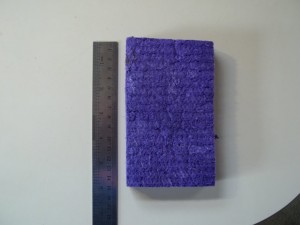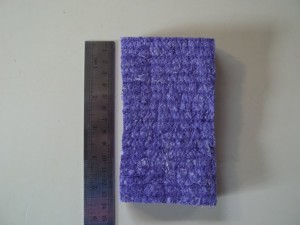Humidity, Acclimation and Prevention
I’ve thought long and hard about the best analogy for lumber acclimation to diverse environments, and the best advice I can give is the same advice that’s been given for years, and by people much more informed than myself on the subject: Proper acclimation continues to be the key to a positive installation result.
Think of a set of brand new kitchen sponges. Each comes sealed in the packaging with equivalent moisture content. There IS some moisture in these items—we can see that over the life of the sponge and its behavior after several uses. The drying and wetting processes of normal usage expand and contract the sponge based on the equivalent moisture found in the item.
Consider the two pictures of the same sponge here. The heater is currently running, so the air inside this place is likely as dry as Death Valley (in terms of relative humidity). The heating system installed here has no humidifier, so the only source of additional moisture is a pot of simmering water that I occasionally keep on the stove.
A Comparison: The Sponge
In the first shot, we see the sponge, dried beyond its normal level of atmospheric equilibrium by the heating of the house. This isn’t a natural state, but is a product of an extreme environment. It is, however, instructive to think of the necessity of acclimation for interior jobs such as flooring and ceiling installation.
Now, in the second shot, the sponge has been saturated and wrung out. The sponge has lengthened by over a centimeter, over ten percent! (I should have photographed the thickness of the sponge as well. Or perhaps a dry and wet one back to back. Oh, well. Ansel Adams I am not. In any event, the sponge very nearly doubled in thickness after being soaked.) Now, I understand comparing sponges to lumber is a little further than comparing apples and oranges. The processes that drive the expansion and contraction of the sponge are quite similar to those that affect lumber, or any other organic building material.
Expansion and Contraction
Thermal expansion and contraction should be considered when installing your product. Drive over a bridge of any length sometime. The expansion joints keep the structure looking and performing more or less the same over time. On an atomic level, heat will generate greater elemental activity, making the matter expand. (Water is a funny element in this regard—Freezing this liquid actually causes an expansion of the matter at play.)
A person can get as scientific as they want when considering the affects of humidity on their installation. The best policy remains the one that has been in play for hundreds of years. Allow ample time (we recommend a minimum of three weeks) to allow your product to adjust to its new environment. This isn’t perfect, but very few things ever are. This rule of thumb works very well for most exterior (and interior—the time may be sped a bit in this case) installations.
